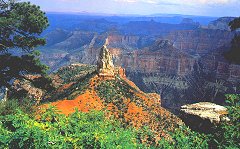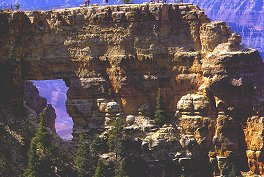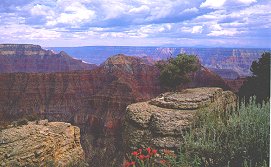The Colorado River has been a moving force in the erosion that has created the Grand Canyon. From raging waters, to delicate trickles, water abounds. In Major Powell's journal in August of 1869, he wrote:
|
"We pass a stream on the right, which leaps into the Colorado by a direct fall of more than a hundred feet, forming a beautiful cascade. There is a bed of very hard rock above, thirty or forty feet in thickness, and much softer beds below. The hard beds above project may yards beyond the softer, which are washed out, forming a deep cave behind the fall, and the stream pours through a narrow crevice into a deep pool below. Around on the rocks, in the cave-like chamber, are set beautiful ferns, with delicate fronds and enameled stalks...This delicate foliage covers the rocks all about the fountain, and gives the chamber great beauty. But we have little time to spend in admiration, so on we go." There is a bed of very hard rock above, thirty or forty feet in thickness, and much softer beds below. The hard beds above project may yards beyond the softer, which are washed out, forming a deep cave behind the fall, and the stream pours through a narrow crevice into a deep pool below. Around on the rocks, in the cave-like chamber, are set beautiful ferns, with delicate fronds and enameled stalks...This delicate foliage covers the rocks all about the fountain, and gives the chamber great beauty. But we have little time to spend in admiration, so on we go." |
|
One wonders if the Major was describing Havasu Falls. The falls are a part of Havasu Creek, a tributary of the Colorado River. It flows thru Havasu Canyon and the village inhabited by the Havasupai people. In 1970, Havasupai land holding increased greatly as the result of a congressional decree to enlarge Grand Canyon National Park, and now include traditional grazing lands.
On the north rim of the Grand Canyon stands the Grand Canyon Lodge. The guest house, built in 1928 by the Union Pacific railroad, is listed on the National Register of Historic Places. Eleven miles east of the lodge is Point Imperial, the most popular lookout on the north rim. At an elevation of 8,803 feet, it is the highest vista point at the park. It offers views of the Vermilion Cliffs in Utah to the north, the Painted Desert to the east, the Little Colorado River canyon to the southeast and Mount Hayden, within the Grand Canyon. guest house, built in 1928 by the Union Pacific railroad, is listed on the National Register of Historic Places. Eleven miles east of the lodge is Point Imperial, the most popular lookout on the north rim. At an elevation of 8,803 feet, it is the highest vista point at the park. It offers views of the Vermilion Cliffs in Utah to the north, the Painted Desert to the east, the Little Colorado River canyon to the southeast and Mount Hayden, within the Grand Canyon.
Cape Royal is one of four plateaus that comprising the north rim of the Grand Canyon. The forest and wildlife environments of Cape Royal are tend to be more mountainous than on the south rim of the canyon. From the lookout, a large slice of the Grand Canyon is visible. Angel's Window, a large hole that has been formed by fractures and weathering, can be seen through the projecting ridge of Cape Royal. At Angel's Window Overlook, on Cape Royal, the Cliff Springs Trail begins. The trail passes ancient dwellings, winds beneath a limestone overhang, and terminates at Cliff Springs, where it then opens from the forest on another impressive view of the canyon. mountainous than on the south rim of the canyon. From the lookout, a large slice of the Grand Canyon is visible. Angel's Window, a large hole that has been formed by fractures and weathering, can be seen through the projecting ridge of Cape Royal. At Angel's Window Overlook, on Cape Royal, the Cliff Springs Trail begins. The trail passes ancient dwellings, winds beneath a limestone overhang, and terminates at Cliff Springs, where it then opens from the forest on another impressive view of the canyon.
Point Sublime, on the north rim is only accessible to visitors driving pickups or four-wheel-drive vehicles with high-road clearance. The road weaves and winds for seventeen miles through beautiful high country to the Point. Overnight camping is available here, but a permit must be obtained from the Backcountry Office at the park ranger station first. Point Sublime reaches an elevation of 7,549 feet, which allows for the the San Francisco Peaks near Flagstaff to be seen. four-wheel-drive vehicles with high-road clearance. The road weaves and winds for seventeen miles through beautiful high country to the Point. Overnight camping is available here, but a permit must be obtained from the Backcountry Office at the park ranger station first. Point Sublime reaches an elevation of 7,549 feet, which allows for the the San Francisco Peaks near Flagstaff to be seen.
In 1919, the Grand Canyon became a national park, in order to share under the canopy of protection offered by the United States. The mission of the National Park Service, is to preserved the parks and all of their features. This includes the processes that created them. The Park Service strives to provide enjoyable activities and visits for park guests, in a manner that will leave the parks unspoiled for generations to come. When President Roosevelt visited the canyon, he proclaimed it to be "the most impressive piece of scenery I have ever looked at." These are words that have echoed from the hearts and lips of visitors from around the world, when their eyes scan over this gem of nature. Park Service, is to preserved the parks and all of their features. This includes the processes that created them. The Park Service strives to provide enjoyable activities and visits for park guests, in a manner that will leave the parks unspoiled for generations to come. When President Roosevelt visited the canyon, he proclaimed it to be "the most impressive piece of scenery I have ever looked at." These are words that have echoed from the hearts and lips of visitors from around the world, when their eyes scan over this gem of nature. |






















